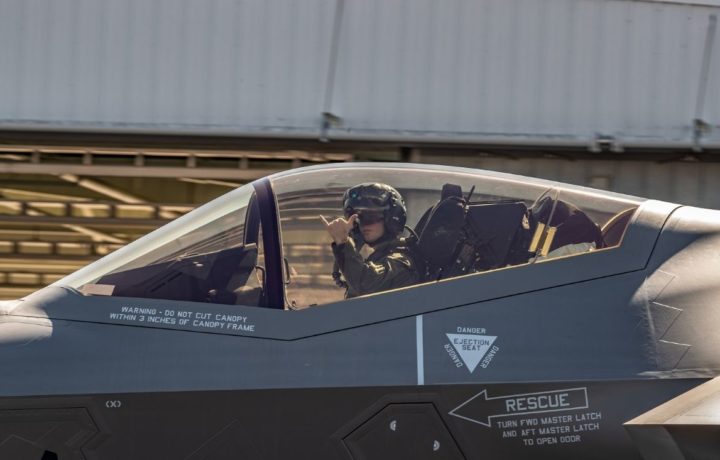The U.S. DoD may have sent a strong message to Moscow by deploying a number of combat aircraft to Europe, where they’ll conduct regular patrols along NATO’s eastern flank. Among those aircraft that will be taking part in the sorties will be the F-35 Lightning II, the most advanced – and expensive – combat aircraft in the U.S. military’s arsenal.
The F-35 Joint Strike Fighter is currently in service in three variants, including the United States Air Force’s F-35A, a conventional take-off and landing model; the United States Marine Corps’ F-35B, a short takeoff/vertical landing (STOVL) version; and the F-35C, a carrier-based variant that is operated by both the United States Navy and Marines. All three variants have similar performance characteristics and the exact same advanced avionics. The variation between models allows military forces to achieve service-specific mission capability, while still taking advantage of the economies of scale that result from the parts and processes that are common to all three variants.
Keeping the Peace in the Skies
On Sunday, the U.S. Air Forces in Europe and Air Forces in Africa announced that the fifth generation fighter aircraft had been repositioned in the Baltic Sea region to support the on-going NATO Enhanced Air Policing missions.
“The 388th Fighter Wing’s initial six F-35 aircraft supported a variety of NATO’s defensive air policing objectives while forward deployed,” the Air Forces in Europe said in a statement, and added that after completing the patrol sorties, the aircraft returned to Spangdahlem Air Base, Germany, while the 52nd Fighter Wing continues to support coalition objectives in Romania with F-16 Fighting Falcon aircraft.
Some of the 388th Fighter Wing’s aircraft are now reportedly operating out of Romania’s 86th Air Base, which is less than 100 miles from where the Danube River forms the border with Ukraine.
A dozen of the F-35A Lightning II jets from the 34th Fighter Squadron, out of Hill Air Force Base (AFB), Utah, arrived at Spangdahlem on Feb. 16 as Russian forces were continuing their build-up along the borders of Ukraine.
“The deployment of U.S. F-35As to Spangdahlem Air Base increases the defensive posture of the NATO Alliance and enhances our ability to operate together,” said Gen. Jeff Harrigian, Commander U.S. Air Forces in Europe and Air Forces Africa and Commander Allied Air Command. “We are facing a dynamic environment and this deployment significantly enhances our support to NATO’s defenses.”
As part of the 388th Operations Group (388 OG), the 34th Fighter Squadron was the first operational F-35A Lightning II fighter squadron in the world. It was declared combat-ready in August 2016 after transitioning from the F-16 Fighting Falcon in September of the previous year.
The F-35 Patrols Will Continue
An additional six F-35 aircraft from the U.S. Air Forces at Royal Air Force Lakenheath’s 48th Fighter Wing were also deployed to Amari Air Base, Estonia, and Siauliai Air Base, Lithuania, and will continue bolstering NATO’s presence in the Baltic Sea region alongside a number of F-15E Strike Eagles that had been deployed to Poland earlier in February.
Lakenheath, which is located 70 miles northeast of London, had received its first delivery of F-35A Lightning II aircraft last December. The base was selected in 2015 to host the first U.S. F-35A squadrons in Europe based on very close ties with the Royal Air Force (RAF), existing infrastructure and combined training opportunities.
The U.S. Air Forces in Europe and Air Forces Africa, in response to the U.S. Secretary of Defense’s order, continues to enhance NATO’s fighter capabilities in the Baltic and Black Sea regions.
Partner Aircraft
American F-35s are currently serving as a deterrent to Russia’s invasion of Ukraine. And the fifth-generation stealth fighter is now being employed by several NATO partners, and even traditionally neutral nations in Europe.
It was reported in January that aerospace giant Lockheed Martin had surpassed its 2021 production goal for the F-35, which followed the news that the governments of Switzerland and Finland each chose the highly capable combat aircraft for their respective fighter jet fleets. In December, Helsinki gave the green light to order 64 F-35s with weapon systems in a deal worth $9.4 billion dollars. Switzerland has also moved forward with its plan to acquire an unspecified number of the combat fighters.
Other NATO partners are now starting to employ the F-35 as well.
Denmark received its first F-35 last year while the Royal Netherlands Air Force (RNAF) had become the eighth nation to declare its fleet of F-35s ready for initial operational capability (IOC).
Other F-35 Milestones
2021 was a year of several milestones for the Joint Strike Fighter program, and that included the first operational deployment of the U.S. Navy’s F-35C aboard the aircraft carrier USS Carl Vinson (CVN-70) last August.
In addition, the joint air wing of F-35Bs of Royal Air Force and United States Marine Corps was embarked aboard HMS Queen Elizabeth, the Royal Navy’s new flagship aircraft carrier, which took part in her nearly nine-month-long maiden deployment. During that time the F-35s took part in combat operations in the Middle East, and performed in joint training missions with several partner nations including Japan and South Korea, and flew nearly 1,300 sorties.
“The F-35 joint enterprise team continues to provide unmatched combat capability to the 21st-century battlespace through the F-35,” said Bridget Lauderdale, vice-president, and general manager of the F-35 program, via a statement in January. “Providing unparalleled support to the growing fleet, participating in numerous joint-all domain exercises and meeting our delivery target during a global pandemic is no small feat, while the F-35 was also chosen by Switzerland and Finland as their next fighter.”
According to standard industry-accepted economic forecasting, the F-35 is also currently responsible for more than 254,000+ direct and indirect U.S. jobs. Yet, what may be most notable is that the highly capable aircraft will hopefully detour Putin from making any rash decisions even as he has much of Eastern Europe in his crosshairs.




